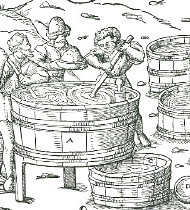print version......
The History of Black Powder
- an entirely new view
Introduction: About 20 years ago, I started my first investigations into the history and chemistry of black powder by studying the usual, readily available literature you certainly have consulted too. This due to becoming a member of a muzzle loader club. Dismayed by the repetitive guesswork, suggestions and quotations by authors who quoted other authors, I started to review some of the original literature, supported by my limited knowledge of Latin and some Chinese. I collected an ever increasing documentation of findings and began to write a book about this. Then, after the arrival of the internet, as a starter, I put this story on my home page, at first in its original German version.
Since I feel this paper will be a genuine, new contribution to the real history of black powder and will shed some new light on the topic, I no longer will hide this story from the public and do present it now in English.
Definition of black powder
"A mixture of homogenized saltpeter (KNO3) and charcoal (empirical formula C7H4O). Confined into a closed space, this mixture explodes violently if heated up to 400 centigrade. By adding sulphur to this mixture, the ignition temperature is reduced significantly. The mixture containing sulphur develops white smoke versus the sulfurless powder which burns nearly smokeless."
The term "black powder" first appeared only in about 1890. Before this time it was called "gun powder" or simply "powder". The change of its name became necessary to distinguish it from the recently invented "white powder", as nitro cellulose powder was called at first. It should be noted that gun powder actually was dark-gray to dark cafe-brown and not black. The deeply black colour of todays black powder is caused by the graphite coating, used to improve its flow properties and damp resistance.
Key ingredient is saltpeter. The burning of any organic substance is accelerated by adding saltpeter. That's so obvious; the discoverer of saltpeter certainly would have observed this characteristic property of this new substance right away.
Certainly we'll never find out the real discoverer's name. But let's see if we can narrow the time and place where saltpeter and black powder was discovered.
| Here an experiment with a mixture of saltpeter and sawdust. Note, the burning of any organic solid matter is accelerated by saltpeter. No chemist who analyzed this substance would have overlooked this property. So it seems to be the next step, testing it also with charcoal, particularly because charcoal was omnipresent in laboratories then; in fact their only heat-source. |
||||
| RETURN | ||||
Theophilus, the Monk
This German chemist is called "the monk" for distinguishing him from his namesake, the ancient Greek chemist Theophilus. His real name was Rogerus von Helmarshausen. "Rogerus" is the latinized form of the Old-German first name "Rüdiger" (=famous), in English called Roger. In the 12th century our Theophilus wrote a comprehensive book, predominantly about chemistry "Schedula Diversarum Artium" (paper of miscelaneous arts). He didn't dare to publish it because chemistry was condemned as witchcraft by the church and any violator was threatened by death penalty. Thus this treatise received no attention in the middle ages and fortunately escaped destruction by the Roman church. As late as 1781 it was rediscovered by chance by Gotthold Ephraim Lessing (1729 – 1781) then librarian at the Wolfenbüttel library, Germany. The best modern English translation is by J.G. Hawthorne & C. St. Smith (1963) 1).
This comprehensive treatise does not mention saltpeter nor black powder. By the way, Saltpeter is an important ingredient for glassmaking, an occupation Theophilus proofs to be an expert. If saltpeter had been known to Theophilus, he certainly would have mentioned it. He didn't! So we can safely conclude saltpeter was unknown in the 1100s.
What activities occupied the chemists in the 12th century? Take it from Theophilus - they worked on exactly the same problems as today’s chemists, i.e. drugs, textile dyes, detergents, metals and their alloys, glass and glaze, or making pigments for paints. Especially in glassmaking Theophilus proofed to be an expert.
Indeed, Theophilus was an experienced professional, who obviously obtained his knowledge firsthand. As a fellow professional, you have an intuitive feeling if somebody is an experienced chemist. There are those little hints between the lines, signaling that the author actually has worked in a laboratory himself.
Marcus Graecus and his "Liber Ignum per Comburandum Hostes"
Because of the prohibition of chemistry by the Roman church, Christian alchemists published under pseudonyms. A well know pseudonym is Marcus Graecus (Marc the Greek). It was used by many authors, since anything of Greek origin was highly esteemed.
The macabre meaning of the title "Liber Ignum per Comburandum Hostes" 2) is "book of fire for burning enemies". There are six copies known today. They are stored in the libraries of Paris (2 copies), Vienna, Munich, Nuremberg and Berlin. Most of them are undated. By examining the script and the cover, an estimate of their age is possible. The oldest is ca. 1250, the youngest is dated 1481. According to different experts, the very first issue was published ca. 800. In the course of time its copyists added ever more recipes of their own.
The copies available today are more or less identical and contain about 160 recipes. If typewritten, all the recipes together would fill about six pages. Elucidated here we find the oldest recipe for purifying saltpeter (sal petrosus = salt from stone) and for making black powder. Concerning saltpeter, the following recipes (more or less literally translated from Latin) are interesting
Recipe 12:...Note, there are two kinds of flying fires, whereof the first:
Take 1 part of colophony, the same amount of sulfur and (??) parts of saltpeter. Saturate this thoroughly powdered mixture with linseed oil, which is better than laurel oil. Then fill a reed with it. Ignited, it suddenly shoots away, to any target you wish and burns anything.
Recipe 13: ...The second method to make a flying fire is as follows:
Take 1 pound of sulfur, 2 pounds of charcoal from linden or willow, and 6 pounds of saltpeter. Finely grind these on a marble plate. Then pour this powder into a vessel of your choosing, suitable for flying fire (rocket) or making thunder (blasting).
Recipe 14: ...Note, Saltpeter is a mineral of the earth and is found as brush-like flours on stones.
Dissolve this earth in boiling water, and purify it by filtration. Boil the filtrate by day and by night and then you'll find scales at the bottom of the vessel, solid and clear.
Recipe 33: ...Note: Another flying fire is made from saltpeter, sulfur and charcoal from grape-wood or willow.
They are mixed and poured into a paper tube. Ignited, it suddenly flies into the air. And note: With respect to sulfur you take 3 parts of charcoal, and with respect to charcoal 3 parts of saltpeter.
(Plainly this is: 9 parts of saltpeter, 3 parts of charcoal and 1 part of sulfur. I'd say it is an ideal recipe by modern standards)
Roger Bacon and his search for a universal science
Very often Roger Bacon (1214 – 1292) is credited with the invention of black powder. Certainly he was not the inventor, but he was the very first to give us a precisely dated recipe for black powder.
Roger Bacon was born an English nobleman among several siblings. He studied philosophy at the University of Oxford and finished as a master of arts. It is essential to note that in England he was able to study Aristotle because the rule of Rome was less stringent in England than in the rest of Europe. (Aristotle taught the world had always existed, while the bible taught it was created by an act of will by God, so Aristotle was condemned as a heretic).
In 1245 Roger Bacon followed a call to the University of Paris. This University urgently needed a professor who was familiar with Aristotle. At that time Paris also dared to disobey Rome's ban of Aristotele. Apart from philosophy Bacon also taught rhetoric and logic. One amusing episode I found was that together with his students, he discussed the problem of a grafted tree: Is the soul of this tree in its trunk or is it in the graft? What is your personal opinion, dear reader?
In 1250 Bacon joined the Franciscan Fraternity. Between 1250 and 1260 he studied Hebrew and Greek. He didn't know Arabic, so he had no access to Arabic literature. The time between 1257 and 1267 he spent in a French Franciscan monastery, to which he was banished because of his critical views concerning clerical authority.
During his university time in Paris, Bacon became acquainted with Cardinal Guy de Foulquois of Paris. Foulquois directed Bacon to write a book about a universal science. The two were convinced the science of Christianity could be supported by natural sciences and vice versa.
During his banishment to the cloister, Bacon used his time to write his universal science. It can be assumed that Bacon had once seen an alchemist’s laboratory, but certainly never worked in one. On the other hand, he wrote a treatise about optics. This treatise proves that he personally had done experiments about the refraction of light and studied the cause of the colors of the rainbow.
First he wrote a comprehensive book about all the then known natural sciences, such as alchemy, astrology, medicine, physiological psychology, mathematics, physics and optics. This book is called "Opus Majus" (main work). After this he wrote a supplement, called "Opus Minus" (small work).
What a surprise when, in 1265, his mentor Cardinal Guy de Foulquois became Pope Clement IV !!
Bacon had doubts if Foulqois, now Pope Clement, would ever find the time to read his voluminous books. So he wrote an abstract, called "Opus Tertium". Unfortunately, Pope Clement died three years later, so it's unclear if Pope Clement IV ever read Bacon’s books.
The Opus Tertium is the most interesting book to us black powder friends, because it contains the first concrete and precisely dated black powder recipe (1267). He definitely doesn't claim the invention for himself. He writes "As everyone knows, you can make …." and then he gives away the recipe:
Sed tamen 7 Partes Salpetrae, 5 Partes Coruli et 5 Partes Sulphuris et sic facies tonitrum et coruscationem, sic scias artificium.
In English: Take 7 parts of saltpeter, 5 parts of hazelwood charcoal and 5 parts of sulfur and that makes thunder and lightning, provided you know the art.
With this disclosure I'm contradicing all gossips about a secret black powder anagram, often attributed to Bacon.
Bacon even tells us what bad boys did with this powder to rouse sleeping citizens at night. They made a roll of paper the size of a thumb, then filled it with this powder, closed it at both ends with an iron wire and ignited it!
But don't worry. Bacon’s mixture won't explode. There is too little saltpeter in it by fare. But Bacon may be excused. He wasn't a chemist and certainly knew the recipe only from hearsay. You bet, the bad boys he's citeing knew better.
And the Chinese?
There is persistent gossip that the Chinese invented black powder as early as the 9th century. It's absolutely unfounded and I hope I can contribute to bring this to an end.
The travel of Marco Polo to China in 1271-1298
It is highly probable that the Polos were the first three Europeans to travel to Mongolia. Participants on this journey were Marco, his father Nicolo and his uncle Maffeo. They travelled by ship and on horseback and arrived ca. 1275 at the court of the Kublai Khan in Kanbalik, today Bejing. The three earned the confidence of the Khan. As a consequence, Marco became governor of the recently conquered province Kiang-Nang in China. He remained in this position for 17 years.
At the same time, the Mongols had the Chinese city Hsiang-Yang under siege for three years without success. The indignant Khan discussed the situation with the Polos, who promised to build machines for breaching the walls of Hsiang-Yang.
The Polos then went to the besieged town and built three catapults capable of propelling rocks of 300 pounds as far as 60 paces. With these, the walls of Hsiang-Yang could be broken in due time. A Chinese chronicler reported that the flying rocks created a hissing sound like a storm.
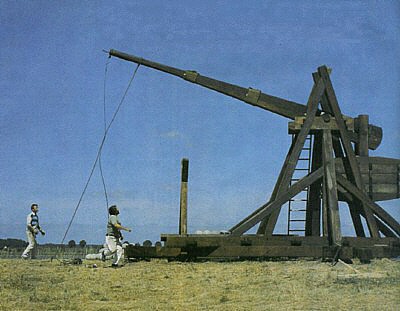 |
||
| Fig. 2: A modern reproduction of a catapult, built for the 700th anniversary of the city of Nykøbing, Denmark in 1989. |
||
After returning to Europe, Marco Polo was imprisoned in Genoa (Italy), where he dictated his story to a fellow prisoner who recorded it in French. This story was translated into English by Yule and Cordier: "The Book of Sir Marco Polo" (1903/1921) 3).
Conclusion: Do you really think, dear reader, the Polos would have built catapults if the Khan had known about black powder, supposedly invented 400 years before? Furthermore, Marco Polo gave us ample details about the daily life in China. It's hard to believe he didn't mention fireworks if he had seen any.
About Chinese Literature
Surfing through the internet, you will find any dates for the invention of black powder, from a.d. 400 to 900. A more serious reference is Wu Jing Zong Yao "Collection of the Most Important Military Techniques", allegedly from 1044. This book is not traceable. There is an earliest, hand written copy of this from the Ming-time passed down to us, dated 1550. So it can't be poven if the given recipes for incendary compositions were added later, something which no serious historian would fail to consider.
All citations you read on the internet or in print, have the following peculiarities in common:
- The references are always cited by Europeans, never by Chinese. At best, the author claims that the text was "translated by a Chinese".
- As a rule, the references cites "an old Chinese book". You never learn the title of the book nor the library in which you'd find it.
- I have never seen a copy of an original text as a proof that the Chinese invented black powder first. Without such proof, it is impossible to examine the claims.
- Only Romoki 7) printed a reference in Chinese characters, allegedly from 1232. Obviously it’s a modern print and the text is too fragmented to proof its truth. The story in this text deals with a fire pot.
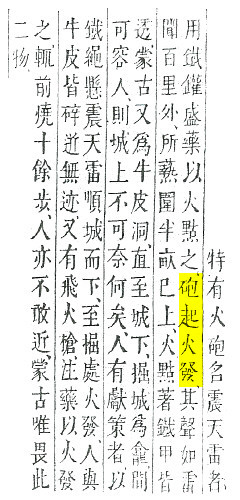 |
|||
| Fig. 3: Using this extract, Romoki tries to prove that the Chinese repelled the besieger of the city of Pien-King (not Peking) with the aid of black powder in 1232. The text I marked yellow concerns a fire pot. Note, it is written between quotes, - a hint its authenticity once was challenged at one time by a Chinese author. And by the way, the marked text is written in modern Chinese |
|||
Konstantin Anklitzen, alias Berthold Schwarz
Born Konstantin Anklitzen he was given the name Berthold when he joined the Franciscan fraternity in Freiburg, Germany, in the first half of the 14th century. In Latin he is referred to as "nigromanticus" which means black artist. From this title he got his present name "Schwarz" which means black. This much about him we can take for granted. There are no personal records available about him.
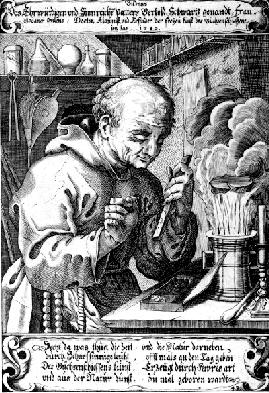 |
|||
| Fig. 4: Copper print from 1640, titled "To the dignified and daedalian father, called Berthold Schwarz, Franciscan, doctor, alchemist and inventor of the free art of gun shooting". |
|||
Beginning in the 15th century, Berthold Schwarz is often referred to as the inventor of guns. That may well be. The first recorded deployment of a cannon was in the defense of Meersburg, a town near Freiburg, by bishop Nikolaus I in 1334. Berthold Schwarz might have witnessed it. Meersburg was the seat of the Bishops of Konstanz and Freiburg, the home region of Berthold Schwarz.
| Fig 5: Today Meersburg, where the first time in history cannons saw action in 1334. |
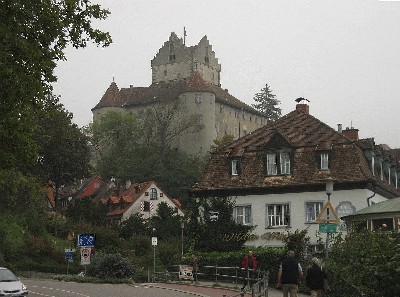 |
||
There might be some truth to this story, although he certainly can’t be considered the inventor of black powder. He was born at least 100 years too late. In Germanic countries many believe black powder (Schwarzpulver) is named for its inventor Schwarz. That’s like believing the frying-pan was invented by Mr. Fry.
By the way, the term "black powder" was used only after 1890. That was to distinguish it from "white powder" as gunpowder from nitro-cellulose was first called. The oldest source mentioning Berthold Schwarz is the "Feuerwerkbuch" 3), written in Allemanish (my native language) in about 1420. If you want to browse the source, then klick here and find a copy of this document.
The oldest known picture of a gun was published in a manuscript by Walter de Millete, titled "De Officilis Regnum" (The Duties of a King), stored in an Oxford library. Millete dedicated this educational book to young King Edward III.
The following picture shows a vase shaped cannon, about to fire an arrow projectile. Note, it is ignited by a slow match, fastened to the end of a cane.
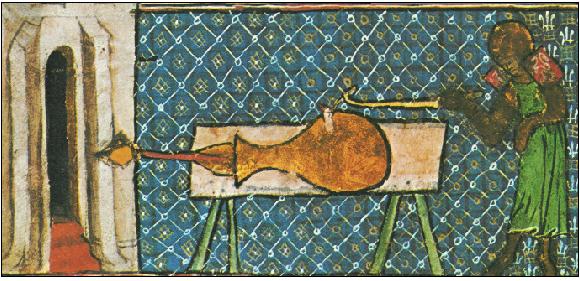 |
||
| Fig. 6: Oldest picture of a firearm, 1326 |
||
Last updated: Sept. 2009
- J.G. Hawthorne & C. St. Smith (1963) : "On Divers Arts"
- Marcus Graecus: "Liber Ignum per Comburandum Hostes" (The Vienna copy, available as micro photographs)
- Das Feuerwerkerbuch (1420) Worlds first treatise about warfare with firearms. Written in Allemannish German, my Swiss mother-tongue. The Fireworkbook (a translation into English is pending)
- Georg Agricola: "De re metallica" (1556) (Of Minig and Smelting)
- Hans Jakob Christoffel von Grimmelshausen: "Simplicissimus" (1668). Among others about the making of priming powder and slow-matches
- Yule and Cordier: "The Book of Sir Marco Polo" (1903/1921).
- S.J. von Romocki "The History of Explosives" (1896/2004)
- John Maxon Stillman: "The story of Early Chemistry" (1924)
- Mukhtar Rasa'il Jabir ign Hayyan, edited and published by P. Kraus, Cairo (1935)
- St. C. Easton: "Roger Bacon and his Search for a Universal Science", Oxford (1962)
- J.R. Partington: "Greek Fire and Gunpowder" (1960)
